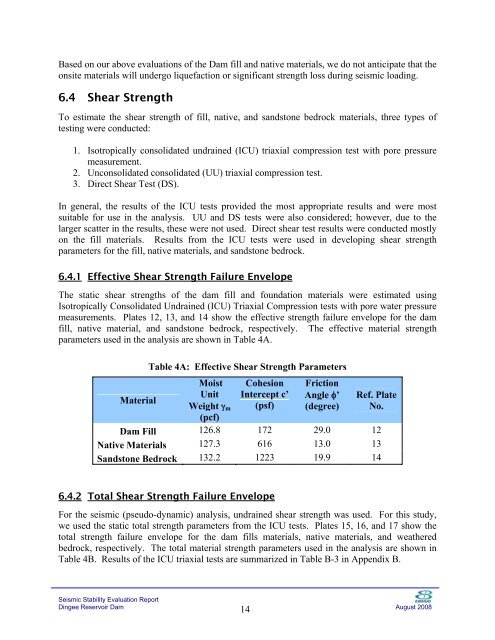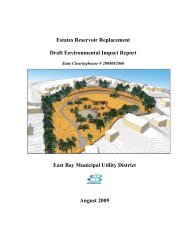Dingee Reservoir Final Seismic Report - East Bay Municipal Utility ...
Dingee Reservoir Final Seismic Report - East Bay Municipal Utility ...
Dingee Reservoir Final Seismic Report - East Bay Municipal Utility ...
- No tags were found...
You also want an ePaper? Increase the reach of your titles
YUMPU automatically turns print PDFs into web optimized ePapers that Google loves.
Based on our above evaluations of the Dam fill and native materials, we do not anticipate that the<br />
onsite materials will undergo liquefaction or significant strength loss during seismic loading.<br />
6.4 Shear Strength<br />
To estimate the shear strength of fill, native, and sandstone bedrock materials, three types of<br />
testing were conducted:<br />
1. Isotropically consolidated undrained (ICU) triaxial compression test with pore pressure<br />
measurement.<br />
2. Unconsolidated consolidated (UU) triaxial compression test.<br />
3. Direct Shear Test (DS).<br />
In general, the results of the ICU tests provided the most appropriate results and were most<br />
suitable for use in the analysis. UU and DS tests were also considered; however, due to the<br />
larger scatter in the results, these were not used. Direct shear test results were conducted mostly<br />
on the fill materials. Results from the ICU tests were used in developing shear strength<br />
parameters for the fill, native materials, and sandstone bedrock.<br />
6.4.1 Effective Shear Strength Failure Envelope<br />
The static shear strengths of the dam fill and foundation materials were estimated using<br />
Isotropically Consolidated Undrained (ICU) Triaxial Compression tests with pore water pressure<br />
measurements. Plates 12, 13, and 14 show the effective strength failure envelope for the dam<br />
fill, native material, and sandstone bedrock, respectively. The effective material strength<br />
parameters used in the analysis are shown in Table 4A.<br />
Material<br />
Table 4A: Effective Shear Strength Parameters<br />
Moist<br />
Unit<br />
Weight m<br />
(pcf)<br />
Cohesion<br />
Intercept c’<br />
(psf)<br />
Friction<br />
Angle’<br />
(degree)<br />
Ref. Plate<br />
No.<br />
Dam Fill 126.8 172 29.0 12<br />
Native Materials 127.3 616 13.0 13<br />
Sandstone Bedrock 132.2 1223 19.9 14<br />
6.4.2 Total Shear Strength Failure Envelope<br />
For the seismic (pseudo-dynamic) analysis, undrained shear strength was used. For this study,<br />
we used the static total strength parameters from the ICU tests. Plates 15, 16, and 17 show the<br />
total strength failure envelope for the dam fills materials, native materials, and weathered<br />
bedrock, respectively. The total material strength parameters used in the analysis are shown in<br />
Table 4B. Results of the ICU triaxial tests are summarized in Table B-3 in Appendix B.<br />
<strong>Seismic</strong> Stability Evaluation <strong>Report</strong><br />
<strong>Dingee</strong> <strong>Reservoir</strong> Dam<br />
14<br />
August 2008

















